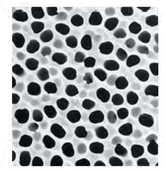Molecular Capsules transport pigments and active agents
Polysiloxane nanoparticles with a core and shell reveal promising applications
Advertisement
We know them from cosmetics ads. liposomes are little balls of fat that carry their cargo deep into the inner layers of skin. Aside from liposomes, there are a number of other nanoscopic capsule systems for vastly different applications. Chemists at the University of Mainz have now developed a new, highly flexible type of capsule.
Liposome-type nanocapsules consist of many individual subunits, which aggregate into a hollow sphere. However, a change in external conditions can cause these structures to fall apart. Capsules made of tightly bound building blocks are stable, but their synthesis tends to be quite costly. The new class of capsules made by the Mainz research group headed by Michael Maskos is relatively easy to produce. The chemists polymerized silicon-carbon compounds to form nanoparticles made of long cross-linked chains. This process results in polyorganosiloxanes with a core-and-shell structure. The researchers have three different variations on this structure in their assortment. Common to all three types is the hydrophobic shell. The chemists additionally include charged groups inside the particles. These provide a hydrophilic environment on the interior. Type 1 has a solid hydrophilic core, type 2 has a hydrophilic inner shell and a soft core, and type 3 has a hydrophilic inner shell around a cavity. Maskos and his colleagues have shown that all three types can be filled with hydrophilic pigments while also being soluble in organic solvents. Different dyes prefer different types of capsules. Encapsulation could protect pigments in car enamel or ink-jet printers from environmental effects, and otherwise insoluble classes of pigments could be made accessible for new varnishes.
Capsules with such properties are theoretically also capable of transporting polar pharmaceutical or cosmetic agents through the skin or through cell membranes and releasing them in a time-delayed process. Variation of the building blocks makes nanocapsules with a variety of properties accessible. It would thus be possible to control the rate of release for an encapsulated substance by means of the number of charged groups on the interior. The size of the gaps in the exterior shell can also be deliberately set. This allows for control over which molecules can enter - enabling the use of the capsules as nano-reaction-vessels or as "containers" for catalysts, for example.
Other news from the department science
These products might interest you
Most read news
More news from our other portals
See the theme worlds for related content
Topic world Synthesis
Chemical synthesis is at the heart of modern chemistry and enables the targeted production of molecules with specific properties. By combining starting materials in defined reaction conditions, chemists can create a wide range of compounds, from simple molecules to complex active ingredients.

Topic world Synthesis
Chemical synthesis is at the heart of modern chemistry and enables the targeted production of molecules with specific properties. By combining starting materials in defined reaction conditions, chemists can create a wide range of compounds, from simple molecules to complex active ingredients.






































































